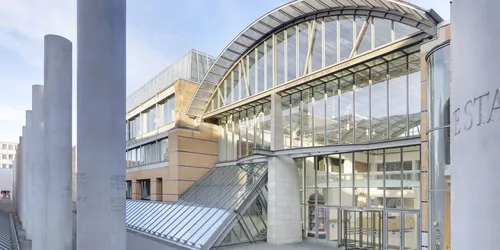Germanic National Museum
The Germanisches Nationalmuseum offers a vivid presentation of high-quality works of art and cultural history from the German-speaking world.

Nuremberg is one of the most important museum locations in Germany, as the following statistics prove: The Franconian city has the highest density of museums per inhabitant of any major German city with a population of half a million or more. There are currently around 60 museums.
The Germanisches Nationalmuseum - a cultural and historical highlight
One of the most important is the Germanisches Nationalmuseum. The collection comprises over 1.3 million artefacts - 25,000 of which are exhibited in a unique architectural ensemble. This makes the Germanisches Nationalmuseum the largest museum of cultural history in Germany. The wide-ranging spectrum extends from prehistory and early history to the art and culture of the second half of the 20th century.
Time travel through the Germanic National Museum
Visitors embark on a journey through time: from the Stone Age hand axe to the Ezelsdorf gold hat from the Bronze Age and the medieval sculptures of the famous sculptors and carvers Tilman Riemenschneider and Veit Stoß to the Behaim globe - the oldest preserved terrestrial globe in the world. Albrecht Dürer's imperial paintings, Rembrandt's self-portrait and Joseph Beuys' felt suit from 1971 round off the cultural journey through the history of the Germanic tribes.
Architecture and additional offers of the Germanic National Museum
The architectural centrepiece of the museum complex is a late medieval Carthusian monastery with its preserved cloisters, church and monks' houses. Neo-Gothic building sections, the glass museum forum created in 1993 and the "Street of Human Rights" created by Israeli sculptor Dani Karavan characterise the museum's external appearance.
But the Germanisches Nationalmuseum is much more than just a museum: it also has a historical archive, the German Art Archive with bequests and estates from the field of fine arts, a coin cabinet and a collection of prints and drawings. The specialised academic library contains over 650,000 volumes on European art and cultural history and is also accessible to museum visitors.
The museum also organises regular special exhibitions on selected topics relating to the art and cultural history of the German-speaking world. The museum also offers exciting and varied programmes for children's birthday parties.
Prices, opening times and further information can be found here.
Culinary experience in the museum
Culture is followed by culinary delights: in the museum's own Café Arte, chef Andreas Maierhofer will spoil you with a small, delicious selection of regional dishes at moderate prices.
How to get to the Germanisches Nationalmuseum
Take the train to Nuremberg Central Station. The museum is about eight minutes' walk from Nuremberg Central Station. Leave the main entrance to the left in the direction of the Nuremberg Opera House. Once you have reached the opera house, the museum is only about two minutes away on your right.
Special exhibitions
Arrival
Kartäusergasse 1
90402 Nuremberg
Nürnberg Hbf
Our tip: Please make sure to check your train connection and the expected capacity before you start your journey.